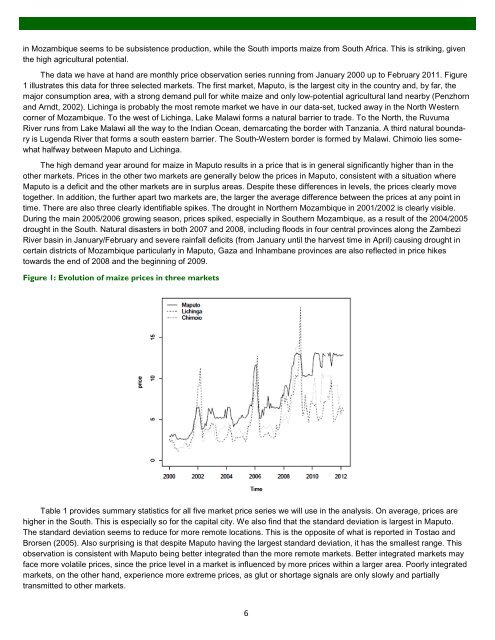Market Integration in Mozambique - International Food Policy ...
Market Integration in Mozambique - International Food Policy ...
Market Integration in Mozambique - International Food Policy ...
Create successful ePaper yourself
Turn your PDF publications into a flip-book with our unique Google optimized e-Paper software.
<strong>in</strong> <strong>Mozambique</strong> seems to be subsistence production, while the South imports maize from South Africa. This is strik<strong>in</strong>g, given<br />
the high agricultural potential.<br />
The data we have at hand are monthly price observation series runn<strong>in</strong>g from January 2000 up to February 2011. Figure<br />
1 illustrates this data for three selected markets. The first market, Maputo, is the largest city <strong>in</strong> the country SUMMARY and, by | APRIL far, the 2010<br />
major consumption area, with a strong demand pull for white maize and only low-potential agricultural land nearby (Penzhorn<br />
and Arndt, 2002). Lich<strong>in</strong>ga is probably the most remote market we have <strong>in</strong> our data-set, tucked away <strong>in</strong> the North Western<br />
corner of <strong>Mozambique</strong>. To the west of Lich<strong>in</strong>ga, Lake Malawi forms a natural barrier to trade. To the North, the Ruvuma<br />
River runs from Lake Malawi all the way to the Indian Ocean, demarcat<strong>in</strong>g the border with Tanzania. A third natural boundary<br />
is Lugenda River that forms a south eastern barrier. The South-Western border is formed by Malawi. Chimoio lies somewhat<br />
halfway between Maputo and Lich<strong>in</strong>ga.<br />
The high demand year around for maize <strong>in</strong> Maputo results <strong>in</strong> a price that is <strong>in</strong> general significantly higher than <strong>in</strong> the<br />
other markets. Prices <strong>in</strong> the other two markets are generally below the prices <strong>in</strong> Maputo, consistent with a situation where<br />
Maputo is a deficit and the other markets are <strong>in</strong> surplus areas. Despite these differences <strong>in</strong> levels, the prices clearly move<br />
together. In addition, the further apart two markets are, the larger the average difference between the prices at any po<strong>in</strong>t <strong>in</strong><br />
time. There are also three clearly identifiable spikes. The drought <strong>in</strong> Northern <strong>Mozambique</strong> <strong>in</strong> 2001/2002 is clearly visible.<br />
Dur<strong>in</strong>g the ma<strong>in</strong> 2005/2006 grow<strong>in</strong>g season, prices spiked, especially <strong>in</strong> Southern <strong>Mozambique</strong>, as a result of the 2004/2005<br />
drought <strong>in</strong> the South. Natural disasters <strong>in</strong> both 2007 and 2008, <strong>in</strong>clud<strong>in</strong>g floods <strong>in</strong> four central prov<strong>in</strong>ces along the Zambezi<br />
River bas<strong>in</strong> <strong>in</strong> January/February and severe ra<strong>in</strong>fall deficits (from January until the harvest time <strong>in</strong> April) caus<strong>in</strong>g drought <strong>in</strong><br />
certa<strong>in</strong> districts of <strong>Mozambique</strong> particularly <strong>in</strong> Maputo, Gaza and Inhambane prov<strong>in</strong>ces are also reflected <strong>in</strong> price hikes<br />
towards the end of 2008 and the beg<strong>in</strong>n<strong>in</strong>g of 2009.<br />
Figure 1: Evolution of maize prices <strong>in</strong> three markets<br />
Table 1 provides summary statistics for all five market price series we will use <strong>in</strong> the analysis. On average, prices are<br />
higher <strong>in</strong> the South. This is especially so for the capital city. We also f<strong>in</strong>d that the standard deviation is largest <strong>in</strong> Maputo.<br />
The standard deviation seems to reduce for more remote locations. This is the opposite of what is reported <strong>in</strong> Tostao and<br />
Brorsen (2005). Also surpris<strong>in</strong>g is that despite Maputo hav<strong>in</strong>g the largest standard deviation, it has the smallest range. This<br />
observation is consistent with Maputo be<strong>in</strong>g better <strong>in</strong>tegrated than the more remote markets. Better <strong>in</strong>tegrated markets may<br />
face more volatile prices, s<strong>in</strong>ce the price level <strong>in</strong> a market is <strong>in</strong>fluenced by more prices with<strong>in</strong> a larger area. Poorly <strong>in</strong>tegrated<br />
markets, on the other hand, experience more extreme prices, as glut or shortage signals are only slowly and partially<br />
transmitted to other markets.<br />
6
















